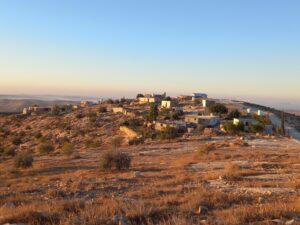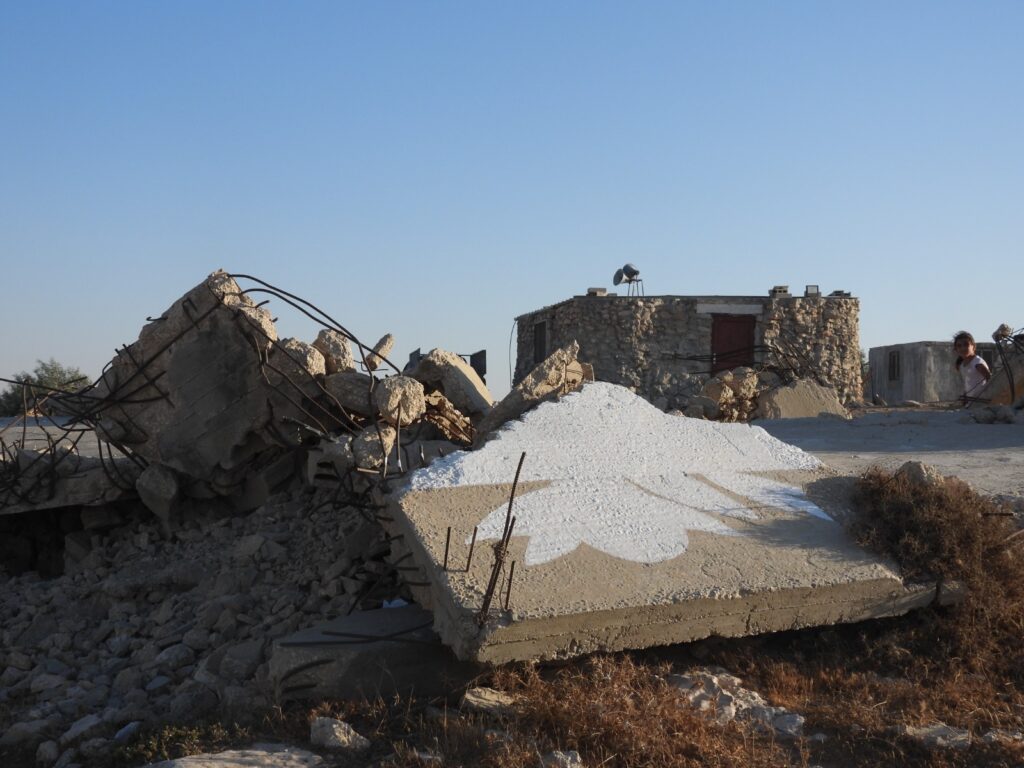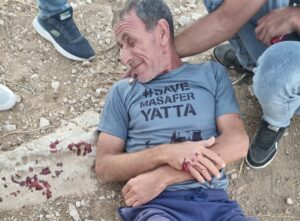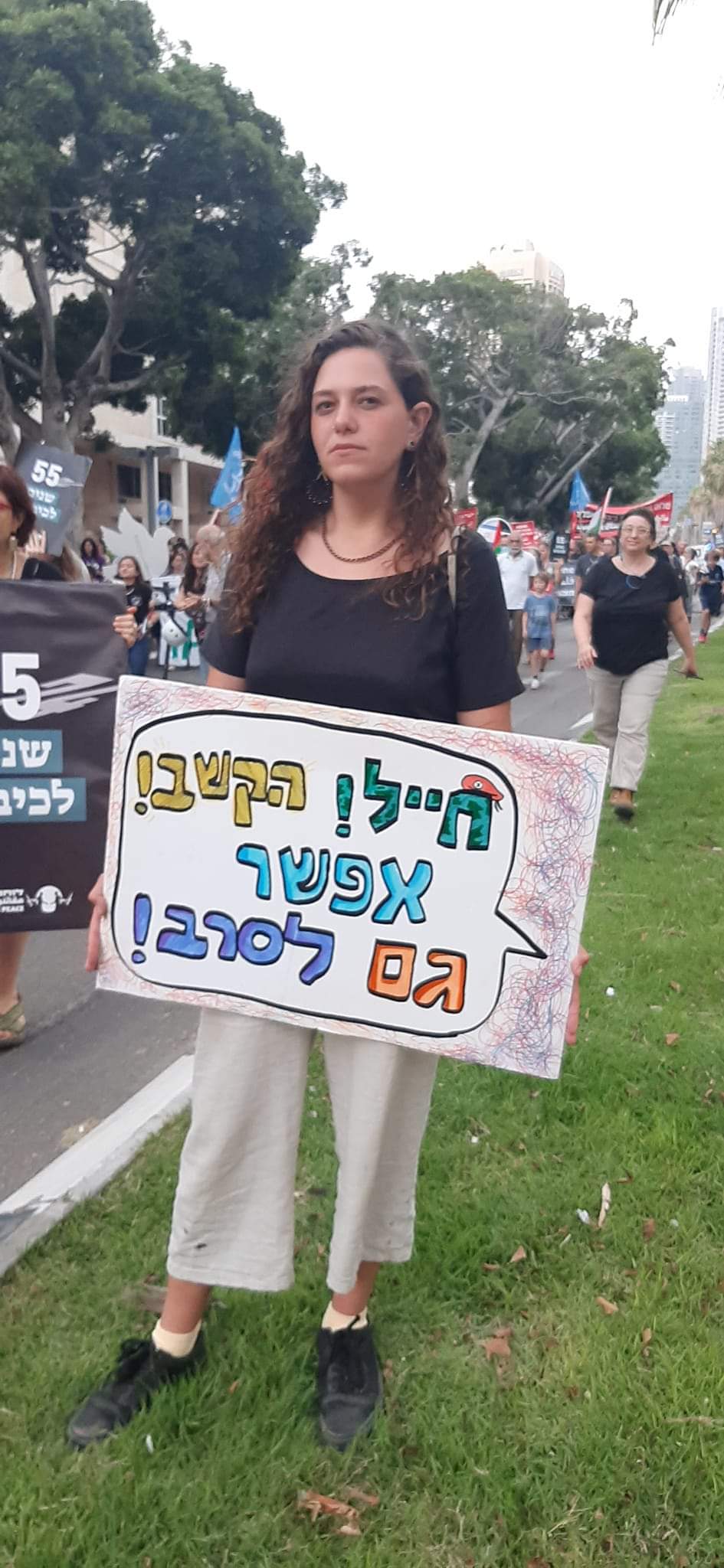Editor’s Note: This article was written on 6/13/22. It therefore describes conditions in the West Bank prior to the most recent explosion of settler violence and even prior to the establishment of the current Israeli government in December 2022.
I have spent most of the past two years living in Masafer Yatta as a solidarity activist against the Israeli occupation. During this time, I’ve witnessed and documented dozens of attacks and crimes committed by settlers and by the Israeli occupation forces. I have come to know the residents of the Palestinian villages very well, and I’ve come to understand the daily oppression they face and the heavy price they pay if they seek to oppose the occupation. As Israeli activists, the regime treats us far more leniently than it does the Palestinians. We choose to exploit this reality in order to attempt to reduce the level of violence directed at the Palestinians. We also seek to expose the truth about what is happening in Masafer Yatta to as many people as possible. The goal is to apply pressure on Israel and on the countries that support it to halt the process of ethnic cleansing between the Jordan and the Mediterranean, and to allow the Palestinians to live in peace.
Introduction
One warm afternoon, as the sun began to set behind the desert hills, a man and his son set out to work in their vegetable plot, situated just above their home. In the fields around them, flocks of sheep and goats grazed peacefully.
In the blink of an eye, they found themselves surrounded by people with masked faces, carrying metal bars and a rifle, who began to attack them. This scene is part of the everyday life for the Palestinian residents of Masafer Yatta—the victims of settler violence.
Background

Masafer Yatta is a beautiful rural area in the south of the West Bank, right at the edge of the desert. The area was occupied by Israel in 1967 and is under the control of the Israeli army. According to the Oslo Accords, signed between Israel and the Palestinian Authority in the 1990s, this part of the West Bank was defined as Area C, under temporary Israeli civilian and military control. The assumption was that most of the area would soon be transferred to the control of the Palestinian Authority. But this “temporary” status has dragged on for decades, and the army still has full control over the area.
Thousands of Palestinians have lived in Masafer Yatta for many generations. Others arrived in the area after they were driven from their homes during the nakba (“catastrophe”) that followed Israel’s Declaration of Independence in 1948.
In the 1980s, Ariel Sharon, who was Minister of Agriculture at the time, declared an area of approximately 30,000 dunams (almost 7,500 acres) in Masafer Yatta as a “firing zone for military exercises.” The area included 12 small Palestinian villages with more than 1,300 residents. Following Sharon’s declaration, Jewish settlements began to spring up between the villages around the area—the area that had been declared as a firing zone! Many of the Palestinian residents lost part of their land—land that had been in their families for generations and was their only source of livelihood. Spacious homes and luxurious neighborhoods were established on the land, housing Israeli citizens who received water and electricity. Large army forces were deployed to “defend” the settlers and entrench the oppression of the Palestinians, who were left defenseless.
Palestinians continued to live in their homes in the firing zone until they were subjected to transfer by the Israeli army in 1999. After a legal struggle, the residents were allowed to return to their homes while the courts continued to discuss their fate. In 2021, the Israeli court ruled that the army was authorized to expel the Palestinian population. Since then, the oppression of the residents has intensified dramatically. They have suffered numerous home demolitions, military exercises conducted between and within their villages, and countless roadblocks designed to deny them freedom of movement.
Over the years, generations of violent people have been raised in the settlements in the area. With the support and assistance of the state, they attack the Palestinian residents. Israeli citizens continue to establish outposts that are illegal even under Israeli law. The army does nothing to prevent this and indeed provides protection for the settlers. The goal of the outposts is to choke the Palestinian villages and prevent Palestinians from farming their land and grazing their flocks for fear of harassment. Within the area declared a firing zone, where the expulsion of the indigenous residents has been approved, Israel outposts terrorize the villages. The army does not enforce the law against the settlers in the outposts.
Throughout the area, the Israeli settlements have received generous allocations of land from the Settlement Division of the World Zionist Organization. By law, Palestinians are prohibited from entering this land. They are left with limited areas in which they must try to make a living for a growing population. The settlers gradually realized that in order to steal land and enjoy state resources, they do not need to attract large numbers of settlers and build entire neighborhoods. All they need is two or three people who set up a tent, bring in a flock and declare that this is their home.
These outposts and individual farms are spreading across the West Bank. The terror they impose is not confined to sporadic physical attacks. They also deny a livelihood to Palestinians, threaten them, steal and vandalize equipment, burn fields, and kill and steal livestock. All this is just part of the daily reality for the Palestinian residents of the villages of Masafer Yatta and other parts of Area C across the West Bank. The level of tension between the Palestinian residents and the Israeli settlers is rising. One side—the Israelis—is proactive, armed and enjoys the protection of soldiers who are authorized to beat, detain and even kill Palestinians in order to defend the settlers. The other side—the Palestinians—are not allowed to keep weapons, have no right to self-defense and have no other source of protection from the occupiers.
How does the system of settler-state violence work?
Who are the Israelis who live in the settlements and outposts of Masafer Yatta? They are a diverse group. Some are wealthy families looking for a beautiful view and plenty of space. Others come to improve their living standards, taking advantage of cheap property prices because no one needs to pay for stolen land. Others are marginalized youth who come under the patronage of the settlers, and some are convicted terrorists who devote most of their time to harassing the Palestinians. The settlers include secular, religious and ultra-Orthodox Jews. All of them take part in the process of dispossession. Some of them actively work to expel Palestinian residents by various means, employing violence themselves or relying on the soldiers, who function as their agents.
The settler population is not large and is certainly much smaller than the Palestinian population in the area. Numerous arms of the Israeli government join in the task of ensuring that the settlers enjoy control and are free to exercise violence. This includes the army, of course, which can sometimes hardly be distinguished from the settlers. Soldiers and settlers work together to detain Palestinians and invade the villages, and it was recently revealed that they even maintain a joint intelligence database. The Israel Police, which is responsible for enforcing the law on Israelis in the area, is present in the settlements, and a lot of the police officers themselves are settlers. Naturally, the police support the settlers and systematically ignore the rights and complaints of Palestinian residents.
Although Jews and Palestinians live in the same area of land, they are subject to different legal systems. The settlers are subject to Israeli civilian law, whereas the Palestinians in the same area live under military law. Palestinians are tried in military courts and held in military detention centers and security prisons. Both the settlers and the army have a clear interest in denying Palestinians their rights.
The media also takes part in the game. The mainstream Israeli media consistently adopts the settler or army narrative when reporting on events in the area. By so doing, they perpetuate and exacerbate a reality in which Israeli citizens know very little about what happens in the Occupied Territories, and most of what they do know is untrue.
What does settler violence look like?

of Mufaqra
The settlers use many different means to oppress and threaten the Palestinian population. These include grazing their flocks on privately owned Palestinian fields, with the added result of terrorizing the landowners and deterring them from using their own land. When landowners dare to come to an area that has been invaded by settlers, they are often subjected to attacks. Attacks also take place inside the Palestinian villages. An example of this is the pogrom that took place in October 2020 in the village of Mufaqra. Dozens of settlers armed with sticks and stones, and accompanied by the army, came down from the outposts of Havat Maon and Avigail, and invaded the village, smashing windows in homes and vehicles. They also used a stone to break the skull of a 3-year old Palestinian boy in the village. While the settlers attacked, the army fired tear gas at the Palestinians to prevent them from defending themselves.
In September 2022, another settler attack took place in the village of Tawani, which is also situated beneath the outpost of Havat Maon. At the time of the attack, an elderly Palestinian man and his son were working in their vegetable garden, which is situated close to their home and is on private land. The two men saw two masked settlers approach a number of shepherds from the neighboring village and drive them away from the scene. The father asked his son to take their flock back from the field to the pen by their home. When he returned, the son and his father were surrounded by settlers, who attacked them with metal bars. One of the settlers, dressed partly in uniform and carrying an army rifle, began to shoot in the air. The father, who was holding a hoe he had been using the garden, attempted to defend himself against the attacking settlers and injured one of them.

The settler fell to the ground. After a few seconds, he stood up, and he and another settler began to return to the settlement. At the same time, a large number of settlers began to arrive on the scene. The Palestinian residents had already called the police by this point and also called for a Palestinian ambulance to attend to the father, who had broken bones in both arms from the beating. By the time the army and police arrived, a large number of settlers had gathered in the private garden. Villagers who heard the gunshots also came to see what was happening. The occupation forces arrived and immediately began to drive the local residents out of the garden, allowing the settlers to invade and uproot trees and plants. When the Palestinian ambulance arrived to take the father to hospital, the settlers and soldiers blocked the way and one settler punctured the vehicle’s tires. The soldiers seized the stretcher with the father on it and put it into an army ambulance. They took the father to an Israeli hospital under military escort. He was shackled to the hospital bed and informed that he was under arrest on suspicion of attacking a settler. He spent the night in the hospital, where the physicians treated his broken bones, and he was then taken for interrogation at a police station before spending 10 days in an Israeli military prison on suspicion of attempted murder.
Immediately after the incident in the garden ended, the Israeli army invaded the village, firing tear gas canisters indiscriminately in all directions. The invasion lasted almost the entire night, as the army forces came in and out of the village, detaining residents at random and continuing to fire gas canisters. The Israeli news media reported the incident, but in their version, Palestinians had laid an ambush and caught an innocent shepherd who had come from the outpost, attacking him and injuring him. As usual, the media asked for comments on the incident from the settlers, the army and the police, but not from the Palestinians who were on the scene.
This incident is a routine occurrence in the Occupied Territories. But there was one difference this time. An international solidarity activist was staying in the village and was on the scene with the family. The activist documented the entire incident from start to finish on his cell phone. The police received the footage, and it also eventually emerged on social and mainstream media outlets. The footage clearly shows the settlers arriving and attacking the Palestinians. The police were in possession of this evidence for 10 days while the father remained in detention.
Some media outlets corrected their mistaken reports. Others didn’t bother. But most Israelis still consider the father to be a terrorist. Meanwhile, the same settlers who attacked him continue to stage pogroms in the area. If the incident had not been documented by an international activist, the father would probably have spent many years in prison.
Conclusion
The incidents described above, and many others like them, show that the settlers who live in the shepherding outposts scattered across the West Bank are very violent people. They clearly assist and accelerate the displacement of Palestinians from the areas around their outposts. It is comforting to imagine that these violent settlers are an outlying group of extremist lawbreakers. But they are not. They are individuals who were raised in the Israeli education system and live in Israeli society, where Palestinians are commonly regarded as terrorists who pose a threat rather than as equal human beings.
The reality described here can only exist because Israel wants it to. This reality produces the desired results. The settlers continue the task Israel began during the nakba, with the ultimate goal of expelling all the Palestinians from the area between the River Jordan and the Mediterranean Sea. It’s true that they are doing this more slowly than the wave of massacres and expulsions that were used to establish the State of Israel following its declaration of independence in 1948. But over the past year alone, at least four Palestinian communities have been unable to bear the terror they face and have fled for their lives. The result is the same, and so is the responsibility of the state for everything that happens.








2 Responses
Excellent article. Tragic reality of Apartheid. Thank you Yasmin for sharing these valuable experiences.
By refusing to accept the conversion of the West Bank into the Palestinian state, the Palestinian Authority has been complicit in the current chaos.